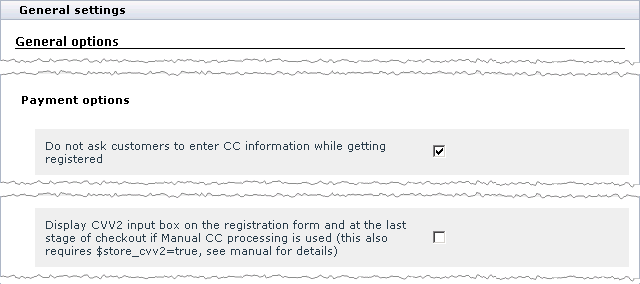Difference between revisions of "X-Cart:PCI-DSS"
(→Configuring X-Cart to meet PCI-DSS with X-Payments application) |
m (→Outsource all processing and transmission of cardholder data (optional)) |
||
| Line 94: | Line 94: | ||
{{Note1|Disabling background payment methods is not required to comply with PCI-DSS but is recommended to eliminate any possible risk of compromising cardholder data.}} | {{Note1|Disabling background payment methods is not required to comply with PCI-DSS but is recommended to eliminate any possible risk of compromising cardholder data.}} | ||
| − | If you want credit card data to be entered on X-Cart side, it's necessary to make sure that your store is implemented in a PCI-compliant hosting environment and your X-Cart is set up in a PCI-compliant manner, i.e. you use a PA-DSS certified software to process credit card payments | + | If you want credit card data to be entered on X-Cart side, it's necessary to make sure that your store is implemented in a PCI-compliant hosting environment and your X-Cart is set up in a PCI-compliant manner, i.e. you use a PA-DSS certified software to process credit card payments. You'll have to fill out PCI [https://www.pcisecuritystandards.org/pdfs/pci_saq_c.pdf SAQ C] in this case. |
==Configuring X-Cart to meet PCI-DSS with X-Payments application== | ==Configuring X-Cart to meet PCI-DSS with X-Payments application== | ||
Revision as of 11:22, 14 October 2010
Contents
PCI Compliance is increasingly important to all online store owners, and X-Cart can be implemented to meet this standard. Follow the steps when implementing X-Cart in a PCI compliant manner.
About PCI DSS
PCI DSS stands for Payment Card Industry Data Security Standard, which is a worldwide information security standard assembled by the major credit card vendors, including American Express, Discover Financial Services, JCB International, MasterCard Worldwide, and Visa, Inc. The standard was designed to help organizations involved in processing credit card payments online make their payment systems secure from cardholder data fraud.
PCI DSS specifies 12 requirements broken into 6 groups for compliance that apply both to hardware and software parts of the system that is used to collect, store, transmit and process valuable credit card data as well as the human factor.
| Build and Maintain a Secure Network |
|
| Protect Cardholder Data |
|
| Maintain a Vulnerability Management Program |
|
| Implement Strong Access Control Measures |
|
| Regularly Monitor and Test Networks |
|
| Maintain an Information Security Policy |
|
To get familiar with aspects of implementing PCI-DSS please study the Braintree PCI-DSS compliance Quick Guide
Configuring X-Cart to meet PCI DSS (cardholder data is not stored)
Disable collecting of credit card data at user registration
If forced, X-Cart can collect customers' credit card details during registration. This is controlled via two check boxes in the section General Settings / General Options of the Admin area:
- Do not ask customers to enter CC information while getting registered: Defines if a customer will be asked to provide credit card details during registration;
- Display CVV2 input box on the registration form and at the last stage of checkout if Manual CC processing is used...: Defines if a customer will be asked to provide CVV2 during registration.
Asking for credit card data during registration must be disabled as shown in the picture below.
Disable storing credit card data in X-Cart database
If forced, X-Cart can store valuable credit card data in an encrypted database. This is controlled via three variables in the main configuration file <xcart_dir>/config.php. You must set the value of all the three variables to false (which is the default setting), and no credit card will be stored in the X-Cart database then.
# file <xcart_dir>/config.php
$store_cc = false
$store_ch = false
$store_cvv2 = falseRemove historical data
Removing historical data, such as card validation codes and other credit card information after the orders using it have been processed and completed, is absolutely necessary for PCI DSS compliance. To remove this data use the Summary > Tools section of X-Cart admin back-end.
Disable Subscriptions module
When the built-in X-Cart module Subscriptions is enabled, X-Cart keeps credit card data stored in its database. Follow these steps to disable the module:
- Log in to the X-Cart Admin area.
- Go to the section Modules (Administration module -> Modules)
- Deselect the check box for the entry Subscriptions.
- Click the Update button at the bottom of the page to save the changes.
Outsource all processing and transmission of cardholder data (optional)
The easiest way to deal with PCI-DSS compliance is to use web-based payment gateways to eliminate the need for customers to enter credit card details on your web-site and thus reduce efforts on meeting PCI-DSS compliance requirements. X-Cart is secure and supports quite a number of such “offsite” payment gateways like Paypal Express Checkout, Google Checkout, WorldPay, 2Checkout, Authorize.net SIM and many more.
If your store has a background payment method enabled, customers input their credit card data on the X-Cart side at the final step of checkout. It is recommended to disable background payment methods using the Settings menu -> Payment methods section of the X-Cart admin back-end. In this case you'll have to fill out the simplest of PCI Self-Assessment Questionnaires (SAQ A).
If you want credit card data to be entered on X-Cart side, it's necessary to make sure that your store is implemented in a PCI-compliant hosting environment and your X-Cart is set up in a PCI-compliant manner, i.e. you use a PA-DSS certified software to process credit card payments. You'll have to fill out PCI SAQ C in this case.
Configuring X-Cart to meet PCI-DSS with X-Payments application
To be sure that cardholder data is entered and transmitted securely on your website during the checkout, it's recommended to use X-Payments application along with X-Cart. Examine the following pages on how to setup secure PCI-DSS compliant environment:
Respectively PCI SAQ C must be completed.
